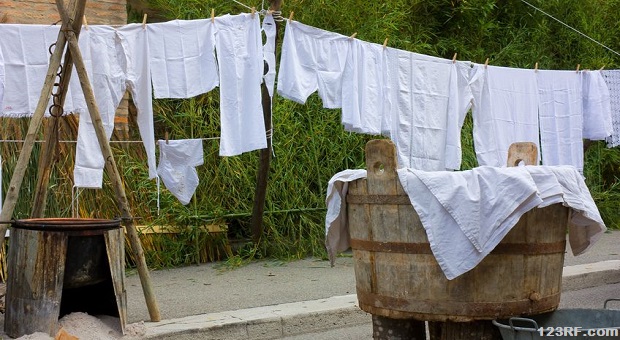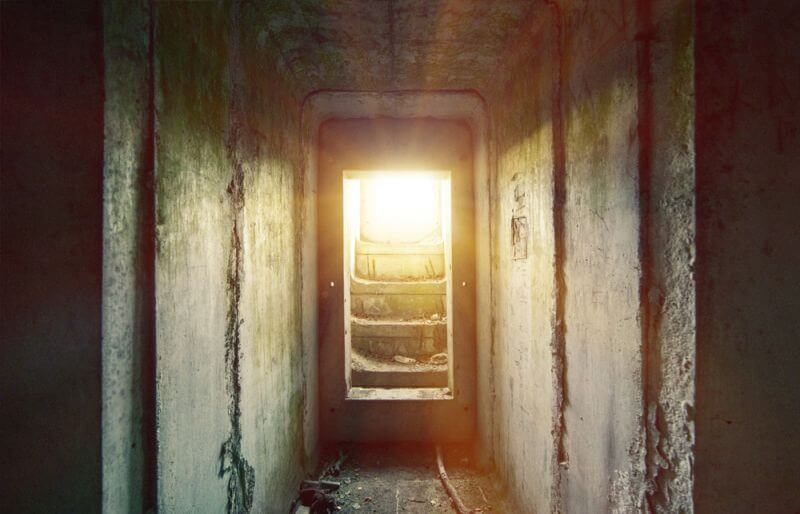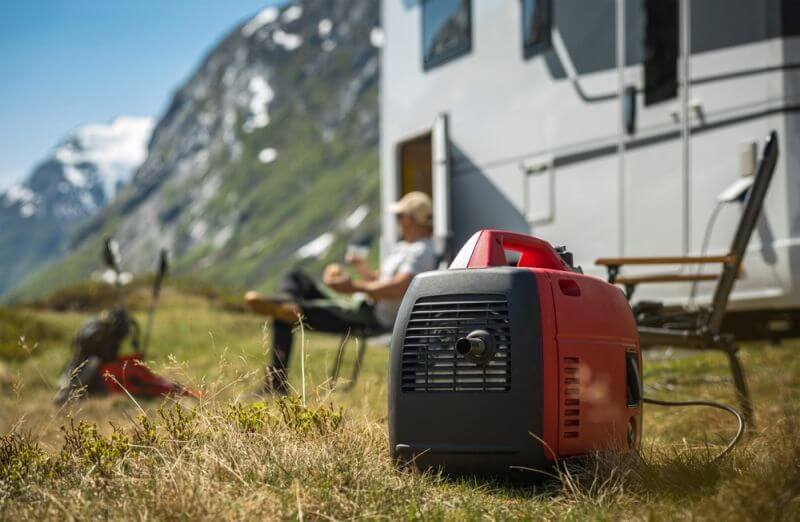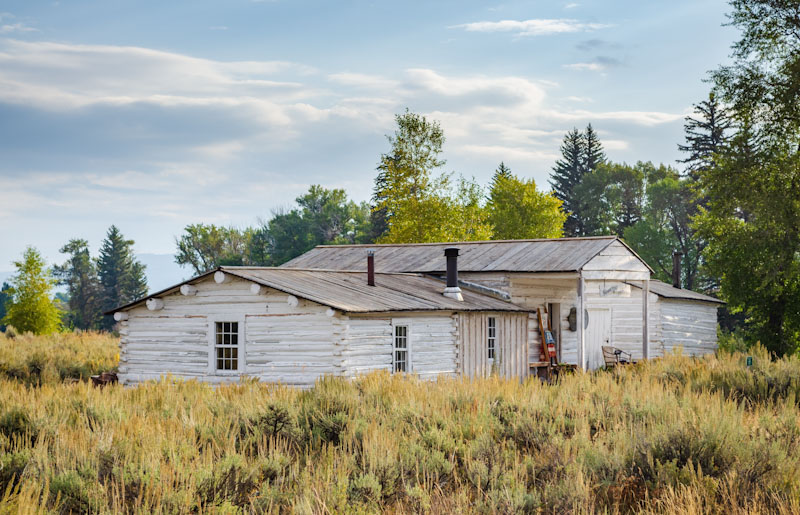Our ancestors did it on a regular basis, but washing clothes without a modern washing machine and dryer is hard work. Unfortunately, it’s going to be a necessary evil during any crisis.
But there are different off-grid methods, so let’s learn how to get your clothes clean as safely and efficiently as possible.
You can, of course, use a washboard and water tub to do laundry but we suggest that you purchase an old wringer washer if you can find one and if you can afford it. They do take up some space but if you actually reach a point where you need it then you’re going to be thankful that you have it, especially if you have a large family. It would also be a killer tool to have if you wanted to trade services because many folks are NOT going to want to use a washboard, or worse yet rocks, to get their clothing clean.
If you can’t find or afford an old wringer washer, you can make your own using various designs. You’ll need a tub, something to stir the laundry with and some way (a wringer, preferably) to remove the water.
That’s not absolutely necessary but the dry time will be much longer if you don’t have a wringer. While watching some of the videos, it looks like a hand-crank pasta or pizza dough press would work well too.
Here are a few ideas to make your own washer for survival.
Bicycle Washing Machine
There’s a design that uses a bicycle to power a modern washer for you engineers and tinkerers that looks relatively simple if you have a bit of know-how.
Basically, a washer works by using a belt that drives the motor, which causes the oscillator to turn inside and clean your clothes. Instead of using electricity, you can modify the bicycle to remain immobile and run the belt, which will run the washer.
Voila! You get clean clothes and exercise at the same time.
Video first seen on Paul Joseph Park.
Dasher Washer
The basin of this washing device is made with a piece of curved steel sheet metal and flat pieces of metal or wood for the sides that you either weld or bolt together then caulk.
There’s a hand-swung dasher (swing bar) that runs along the bottom of the curved (half-circle or half-oval) basin and acts as an agitator to beat the dirt out of your clothes.
All that you have to do is fill it half way or so with water, add soap, place your clothes in, and work the handle back and forth to operate the swing bar in the bottom.
Just in case you’re wondering, effective dimensions for this washer are:
- Dimensions 25in w, 24in long, 17in deep.
- Dasher is a stainless steel swing bar that’s 12 ½ inches around 21 ¼ inches long. It’s attached to the crank with either wood or metal dowels and sits about ½ in off the bottom of the basin.
- The legs are 24” long.
- The sheet metal that forms the basin is 50” long and 24” wide and bent into a half-circle or half-oval shape.
Put a spigot or a plug in the bottom to help you drain the water. You don’t have to do this, but it’s easier than dumping it out.
Video first seen on Eco Jaunt.
2 Five-Gallon Buckets and a Plunger
This is an extremely simple design that will be easier to store if you don’t have a ton of space. The buckets need to be the same size and fit into each other and you need at least one lid.
- First, drill plenty of holes into one bucket so that it looks similar to the inside tub of your washing machine.
- Drill a hole into the center of the lid so that the plunger handle fits in it.
- Put the holey bucket into the intact bucket and place the plunger inside.
- Place water, soap and some clothes into the bucket.
- Put the handle through the hole in the lid and affix the lid.
- Work the plunger back and forth and up and down for several minutes, depending on how dirty your clothes are.
- Remove lid and dump water.
- Fill with rinse water and repeat process. Repeat if necessary to get the soap out.
- Remove lid and pull the holey bucket with the clothes from inside of the intact bucket.
- Place the intact bucket inside of the holey bucket, put the lid on it, and sit on it to smash the water from the clothes.
- If you’d like, you can hang the clothes bucket and spin it to sling the water out, too.
- You’re done!
Video first seen on Tiny House Listings.
Washboard Method
Though this method is backbreaking and time-consuming, it’s certainly an effective option if you have no space in which to store or build one of the other designs. You can buy washboards at yard sales and thrift shops, though they’re becoming rare as time goes on and they become completely archaic.
If you’re just a little bit handy, you can build your own using aluminum or tin and wood. As a matter of fact, if you’re building one, you may want to build several so that you have your “heir and spare” plus possibly a few to barter with.
All that you’ll need to build one washboard is:
- A 12”x20”sheet of corrugated aluminum or tin
- 2 pieces of 2”x4” lumber, 24” long
- 4 dowel rods, 1 ½” in diameter
- ¾” plywood, cut 12”x20”
- Six or eight 1” stainless steel or aluminum screws
This sounds a bit complicated but after you make the first one, you’ll see that it’s really not.
- Draw a line down the center of each 2×4, then measure 3 3/4” from either end, making a mark where the lines intersect.
- Using either mark, measure 5 ½” down, make another mark on the center line, then repeat so that you have 4 equally-spaced marks. Repeat on the other 2×4.
- Using a drill or a hole saw, cut 1 ½” holes over each mark, using the mark as the center. Don’t go too big or else your dowels won’t fit in them properly.
- Place wood glue on the end of a dowel and fit into each hole so that the boards are connected by the “ladder.” Make sure that the ends of the dowels are flush with the outsides of the boards. Allow to dry for a few hours.
- Seal and waterproof the wood and allow to set for 24 hours.
- Place the plywood over the dowels and drive 1 screw through each dowel on either side. The ends will hang over the dowels a bit; that’s OK.
- Now place your aluminum or tin on top of the plywood, trimming off any sides that hang over so that you don’t cut yourself.
- Screw the metal to the plywood in between the ribs, placing a screw every 4 inches or so. Make sure that you get them flush so that they don’t snag your clothes.
- You’re done!
As you can see, any of these wash methods requires a bit of ingenuity but none of them are really difficult, with the exception of the bicycle, perhaps. The important thing is that you’re going to need a way to wash your clothes, and now you have a few ideas!
If you have any suggestions, please share them with us in the comments section below!
This article has been written by Theresa Crouse for Survivopedia.
Sources:
http://velacreations.com/water/water-usage/205.html#step-by-step









Don Turnblade | August 18, 2014
|
To my thinking, proof of a good system can be done in a backpacking environment where water is filtered from natural sources, grey water managed to sustain pure water sources and interesting smells controlled to prevent bear damage.
I can see these demos meeting 1 of three of my evaluation needs.
rick | August 18, 2014
|
Hi, What’s the point of including a “download as pdf” link if it will not
work? The last 3 or 4 articles you posted will not download a pdf.
This feature used to operate. If you have decided to stop offering the
download, why show a link to do so?
Thanks,
Rick
James M Dakin | August 18, 2014
|
Save yourself a lot of work. Put the clothes and water/soap in a five gallon bucket with lid. Place bucket in the seat of a rocking chair. Rope in place. Place chair in front of couch. As you read or otherwise occupy yourself, rock the chair with your foot. Legs are more muscular than arms, so this is much easier. And cheap.
Herbert | August 18, 2014
|
Here is multi-purpose tool that would stand in for a clothes washer:
https://www.youtube.com/watch?v=osrJYGxmH_M
This is principally a concrete and/or mortar mixer but watch the video and see what you think. Price listed here is $24.95 at this time.
William Harrington | August 18, 2014
|
A number of years back, I had occasion to visit friends in Michigan. Not far away in Indiana was a large Amish community. In the area was a store selling a lot of new old fashioned equipment that did not use electricity for the Amish. On e of the items was a hand operated wringer washing machine.
Melody Martin | August 18, 2014
|
save your 5 gallon paint/ Spackleing or other construction type or just buy some 5 gallon buckets with lids a cap full of Woolite or a few squirts of dawn toss undies in bucket cover shake and roll rinse with cold water hang to dry.easy and neat and will not harm sensitive parts (you girls know what I mean)
velma | August 18, 2014
|
I like the double bucket washer and wringer. Great idea! Where were you when my washer didn’t spin?
Wash boards can be bought at https://www.columbuswashboard.com
During the gulf war they shipped them along with tubs for the soldiers to wash their undies and socks.
Deez | August 18, 2014
|
Having done washing by hand for two people. I have bought a hand wringer for clothes. Since I am not handy if a motorized machine were to break, this works and saves my strength for other projects which in a grid down situation, there will be many. Just do a simple web search for “hand wringer for clothes,” you’ll find one to fit your budget. 😉
Great article. I’m also stocking for a few alternatives because I believe in backup plans when possible.
Pingback:Sustainablog | Jeff McIntire-Strasburg has been blogging a greener world via sustainablog since 2003! | August 25, 2014
|
Pingback:Getting off the grid just got a bit easier thanks to this low-tech laundry machine. | Bullet Metro | May 11, 2015
|
Pingback:Getting off the grid just got a bit easier thanks to this low-tech laundry machine. - Seatbelt Guitar | May 12, 2015
|
Pingback:Getting off the grid just got a bit easier thanks to this low-tech laundry machine. - Ice Trend | May 13, 2015
|
Pingback:13 Off-Grid Manual Washing Machine that Won't Numb Your Hands | March 13, 2016
|
Pingback:How To Do Laundry Off The Grid | April 5, 2016
|
George e Warren | July 21, 2016
|
I really like your page.I myself has hung out clothes for many years.its been years that I’ve done this I done it years ago for my mother even.When you put your clothes line up.When it goes throw the eye lets and bring the line back.Put a small piece of rubber hose on the line soo that the hose is on the eye let not the plastic coating on the line itself.If you would like a picture I will send it too you.Ge